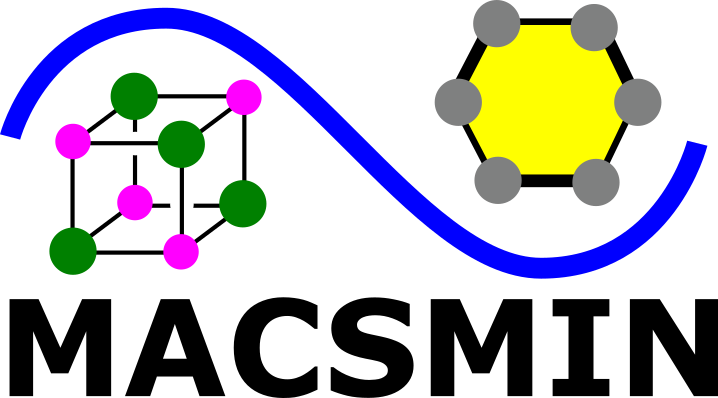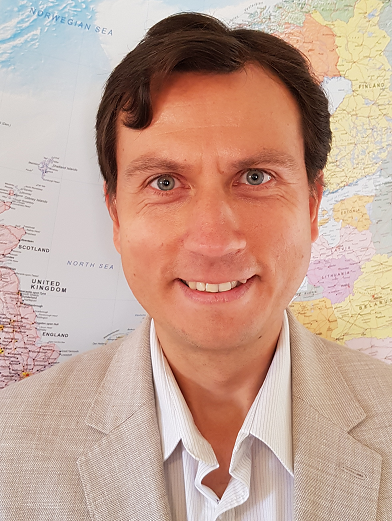MACSMIN 2025: Mathematics and Computer Science for Materials Innovation
 |
The MACSMIN logo includes the basic examples of the rock-salt cubic crystal, the benzene ring, and a blue wave containing a local maximum and a local minimum. |
- Dates: 8-12 September 2025 in a hybrid form in the Materials Innovation Factory, Liverpool, UK.
- MACSMIN 2025 is a satellite of the 35th European Crystallographic Meeting, Poznan, Poland.
- Conference organizers : Vitaliy's Data Science group including Olga Anosova, Dan Widdowson, Will Jeffcott, Yury Elkin, and Jonathan (Teddy) McManus. To participate for free, please e-mail.
- See the invited speakers. Tutorials will be given on latest advances in Geometric Data Science for crystals (Daniel Widdowson), proteins (Olga Anosova), and general molecules (Yury Elkin).
- We plan 8-10 September in person with a conference dinner and 11-12 September on zoom.
- All talks will be aimed for a broad audience of scientists including PhD students and postdocs.
- The conference is funded by the LMS through the network Applied Geometry and Topology.
- Travel information for Liverpool (UK): venue, accommodation, trains, and flights.
- Related meetings: mini-symposium Computational Data Science of Nanostructures (6 hours) at the SIAM annual meeting on July 28 - August 1, 2025 in Montreal: part 1, part 2, part 3.
- The AMS session on Open Problems in Geometric Data Science at JMM 2026, Washington DC.
- The ICERM workshop "Rigidity Theory meets Geometric Data Science for chemistry applications” on 6-10 July 2026, Brown University, Providence (US).
- The regular MIF++ seminar is a continuous version of the annual MACSMIN.
- Past meetings of the MACSMIN series: 2024, 2023, 2022, 2021, 2020.
Invited speakers (in the alphabetical order, exact times will be fixed in July)
- Simon Billinge (Columbia University, US)
- Alex Chernatynsky (Missouri University of Science and Technology, US)
- Title. A symmetry-oriented crystal structure prediction method for crystals with rigid bodies.
- Abstract. We have developed an efficient crystal structure prediction (CSP) method for desired chemical compositions, specifically suited for compounds featuring recurring molecules or rigid bodies. We applied this method to two metal chalcogenides: Li3PS4 and Na6Ge2Se6, treating PS4 as a tetrahedral rigid body and Ge2Se6 as an ethane-like dimer rigid body. Initial trials not only identified the experimentally observed structures of these compounds but also uncovered several novel phases, including a new stannite-type Li3PS4 structure and a potential stable structure for Na6Ge2Se6 that exhibits significantly lower energy than the observed phase, as evaluated by density functional theory calculations. We compared our results with those obtained using USPEX, a popular CSP package leveraging genetic algorithms. Both methods predicted the same lowest energy structures in both compounds. However, our method demonstrated better performance in predicting metastable structures. The method is implemented with Python code which is available at https://github.com/ColdSnaap/sgrcsp.git.
- Andrea Darù (University of Chicago, US)
- Title. Computational tools for the prediction and generation of novel reticular framework materials.
- Abstract. This talk will present recent work on the computational prediction of metal-organic and covalent organic frameworks (MOFs and COFs), with addition of experimental insights. I will focus on the study "Symmetry is the Key to the Design of Reticular Frameworks" (Adv. Mater., 10.1002/adma.202414617), which introduces a computational tool that predicts feasible reticular framework topologies based solely on the connectivity and symmetry of isolated nodes and linkers. Unlike high-throughput methods, this approach prioritizes accuracy by generating a small, targeted set of candidate structures, optimizing computational resources. The tool is at https://rationaldesign.pythonanywhere.com. The talk will conclude with experimental perspectives on the applicability of this method to known and unknown synthesizable structures.
- Graeme Day (University of Southampton, UK)
- Title. Predictive crystallography at scale: learning from an unprecedentedly large collection of crystal structure prediction landscapes.
- Abstract. The talk will discuss the results of scaling crystal structure prediction calculations to over 1000 molecules [1], in an effort at validating global lattice energy minimisation for crystal structure prediction and creating high quality date for learning relationships between molecular structure, crystal structure and properties. I will discuss assessment of the dataset, insights that the data provides on crystallisation behaviour and our future outlook for how such a dataset will be valuable for machine learning methods applied to molecular organic crystals.
[1] Taylor, Butler and Day, Faraday Discussions, 2025,256, 434-458
- Mike Glazer (Oxford University, UK)
- Title. Perovskite structures – a personal journey.
- Abstract. Perovskites are some of the most important crystalline materials because of their vast range of variations and properties. In this talk I shall review the history of structure determination and phase transitions of perovskite materials. This begins in the early 1940's, a time when there were hardly any publications on these materials and when perovskites such as barium titanate were considered to be strategic materials for the war effort. Since then, the amount of interest in the structures of perovskites and their related materials has become stratospheric, so much so that it is now impossible to keep up with the literature. It is clear that there is still a considerable future for research into these important structures, as new variations based on the crystal structures, and therefore their physical properties, are still being made.
- Sergei Grudinin (Grenoble Alpes University, France)
-
- Jason R. Hattrick-Simpers (University of Toronto, Acceleration Consortium and Vector Institute for AI, Canada)
- Title. Methods for Generating Unbiased and Robust A.I.’s for Autonomous Materials Discovery.
- Abstract. Since the publication of the Mission Innovation Materials Acceleration Platform, AI is increasingly responsible for driving automated experimental and computational campaigns. There have been multiple case studies for which autonomy was demonstrated to successfully drive materials optimization or discovery and the world of scientific robots has moved from science fiction to reality. However, within the AI community, it is well understood that AI models carry the biases of their creators, which can have serious implications for model deployment. These models may behave unpredictably, even within the bounds of their training data. Using specific case studies, I will illustrate how such biases arise in materials science and outline steps to mitigate them, leading to more robust models. In particular, I will discuss our recent work on: (1) identifying and mitigating search space bias through model disagreement, (2) quantitatively demonstrating how little basis there is for our biases about dataset completeness, and (3) developing new metrics for evaluating model-data synergies. Finally, I will briefly touch on broader efforts in self-driving lab development within the University of Toronto’s Acceleration Consortium.
-
- Thérèse Malliavin (Université de Lorraine, CNRS, France)
- Title. Investigating a Local Approach for Calculating Protein Conformations.
- Abstract. Protein structure prediction is generally based on
the use of local conformational information coupled with long-
range distance restraints. Such restraints can be derived from the
knowledge of a template structure or the analysis of protein
sequence alignment in the framework of models arising from the
physics of disordered systems. The accuracy of approaches based
on sequence alignment, however, is limited in the case where the
number of aligned sequences is small. Here, we derive protein
conformations using only local conformations knowledge by means
of the interval Branch-and-Prune algorithm. The computation
efficiency is directly related to the knowledge of stereochemistry
(bond angle and ω values) along the protein sequence and, in
particular, to the variations of the torsion angle ω.
The efficiency of predicting torsion angles ω is then evaluated
for various pre-processing of input data-sets.
Reference: da Rocha W, Liberti L, Mucherino A, Malliavin TE. Influence of Stereochemistry in a Local Approach for Calculating Protein Conformations. J Chem Inf Model. 2024 Dec 9;64(23):8999-9008. doi: 10.1021/acs.jcim.4c01232
- Greg McColm (University of South Florida, US)
- Peter Olver (University of Minnesota, US)
- Janos Pach (Rényi Institute, Budapest and EPFL, Lausanne)
- Title. Mysteries about crossing numbers.
- Abstract. For any graph G, the crossing number cr(G) of G is defined as the smallest number k such that G can be drawn in the plane with k crossing points between its edges. The pairwise crossing number pair-cr(G) of G is defined in a similar way, except that in this case we want to minimize the number of crossing pairs of edges. Obviously, pair-cr(G) is at most cr(G). It is one of the most annoying unsolved problems for graph embeddings whether there exists a graph for which these two parameters do not coincide. Since computing these parameters are NP-complete problems, it is difficult to test the inequality even for small graphs. After giving a whirlwind survey of the topic, we discuss some recent developments.
- Fabio Pietrucci (Sorbonne Université, France)
- Marjorie Senechal (Smith College, US)
- Xiaocheng Shang (University of Birmingham, UK)
- Title. Accurate and efficient numerical methods for molecular and particle simulation using adaptive thermostats.
- Abstract. I will discuss how we can use the so-called adaptive thermostats, which rely on a negative feedback loop, to develop accurate and efficient numerical methods for molecular and particle simulations, focusing on applications at mesoscales.
- Isaac Sugden (Cambridge Crystallographic Data Centre, UK)
Travel information: venue, accommodation, trains, and flights
- All talks in person will be in the ground floor boardroom in the Materials Innovation Factory (MIF), Liverpool, UK. Address: 51 Oxford street, building 807 in the grid cell F5 on the campus map. The building has a secure entrance, so we will let the reception know about MACSMIN participants. The MIF is 15 min on foot from the Liverpool Lime Street station.
- If you contact us in advance, we can help with booking hotels. One option is the Liner hotel in a quiet street close to the Liverpool Lime Street main rail station. Explore other good hotels and attractions on the website visit Liverpool.
- The city has the Liverpool John Lennon airport with convenient buses to the centre. The larger Manchester airport has the train station with direct 90-min trains to the Liverpool Lime Street station. Check flights to nearby airports at Skyscanner.
Back to Top of this page | Back to MACSMIN | Back to Home page
